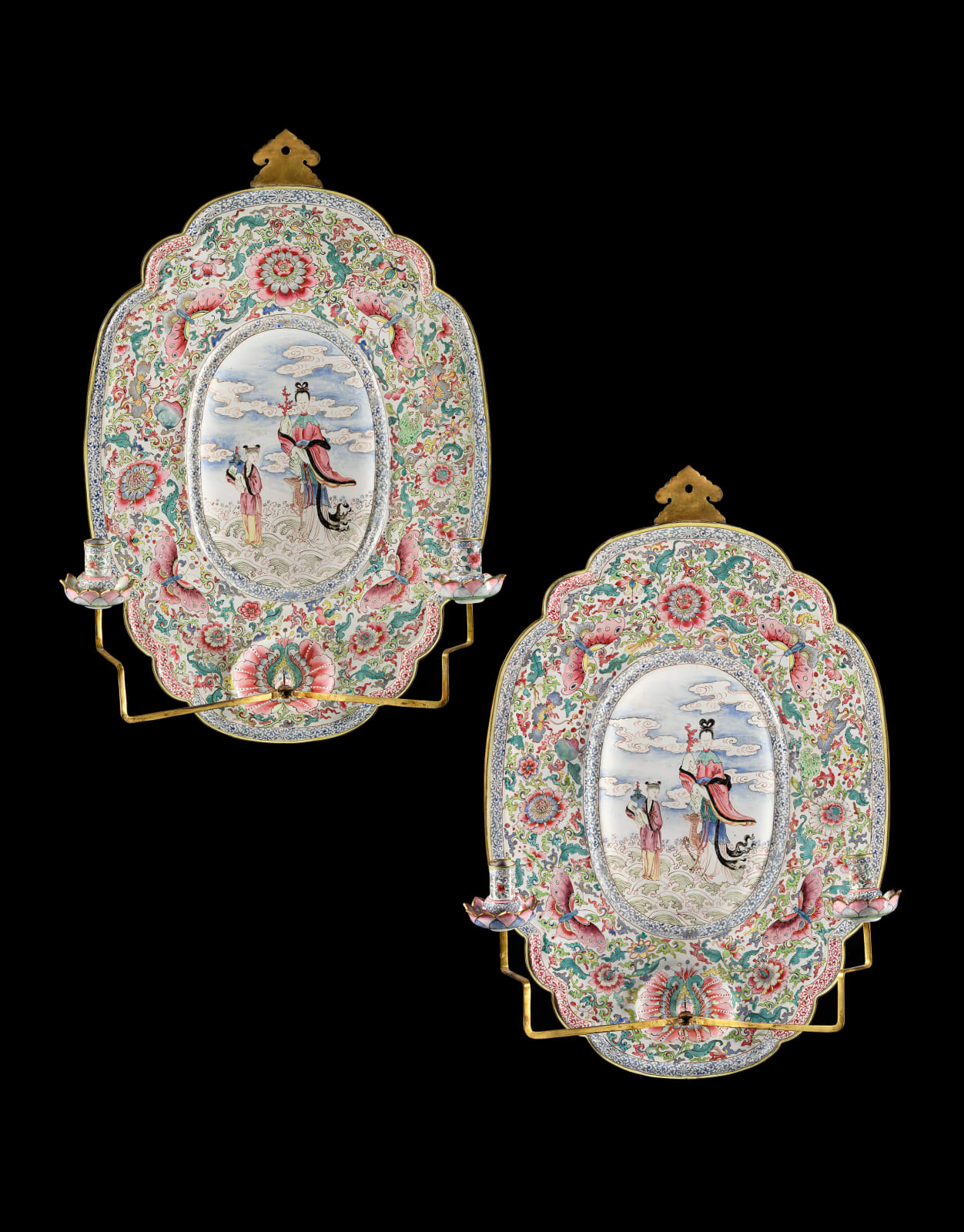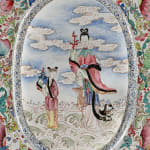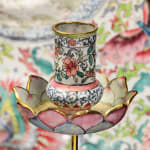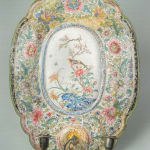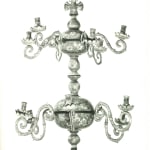A PAIR OF CHINESE FAMILLE ROSE ENAMEL SCONCES
W: 14.5” / 37cm
Further images
Literature
T. B. Arapova, Transactions of the Oriental Ceramic Society, Vol. 81, pp. 55-6, fig. 9
Jenyns, S., Watson, W., Chinese Art, The Minor Arts (London, 1963), p. 264, fig. 123
Hodacs, Hanna, Silk and Tea in the North (London, 2016)
Jan Wirgin, Från Kina till Europa, Östasiatiska Museet (Stockholm, 1998), pp. 238-46
An Exceptionally Rare Pair of Famille Rose Enamel Wall Sconces
Qing Dynasty, Qianlong Period (1736–1795)
This exquisite and exceptionally rare pair of famille rose enamel wall sconces exemplifies the sophistication and innovation of Qing dynasty craftsmanship made expressly for export to elite European clients. Rich in technical refinement and symbolic meaning, each sconce centres on a vibrant cartouche depicting the Daoist Immortal Magu, goddess of longevity, poised on cresting waves with her attendant and a deer—symbols of long life, purity, and transcendence. The figures are enclosed by a sumptuous lobed border filled with finely painted peonies, chrysanthemum blossoms, and butterflies, rendered in the delicate pastel palette associated with famille rose (fencai) enamels. At the base, enamelled lotus medallions issue two finely gilt-bronze arms, each terminating in its original candle holder and drip pan, shaped as open lotus blooms—highlighting the set’s rare completeness and outstanding quality.
These objects were not merely decorative; they were emissaries of Chinese material culture, conceived to dazzle European aristocratic audiences with their exoticism, craftsmanship, and opulence. The sconces were produced in Guangzhou (Canton)—China’s only legal port for maritime trade with the West from the 1750s until the 1840s—where they would have been commissioned either by European merchants or by Chinese agents acting on behalf of Western patrons.
The 18th-century China Trade, as it was called, reached its zenith under the Qianlong Emperor, when demand for Chinese porcelain, lacquer, silk, and painted enamels surged among European courts and wealthy merchant classes. Painted enamel on copper—a technique introduced by Jesuit missionaries and known in China as falangcai or yangcai—was among the most prized categories of export ware. It combined Chinese painting traditions with Western pictorial realism and vibrant overglaze palettes derived from European enamel techniques.
The present sconces were almost certainly made as luxury export wares for royal or noble clients, evidenced not only by their size and complexity, but also by the presence of original European-style gilt-bronze fittings—indicating direct collaboration between Chinese enamellers and Western metalworkers or specifications given by European merchants. Similar objects were imported by the Dutch East India Company (VOC), and as Tatiana Arapova notes (Transactions of the Oriental Ceramic Society, vol. 81, 2016–17), the VOC placed their first documented order for painted enamel wares in 1766, including two-light wall sconces much like this pair.
Further reinforcing their elite status, a closely related pair resides in the State Hermitage Museum, having once belonged to the Anichkov Palace in St Petersburg, residence of Emperor Alexander III and Empress Maria Feodorovna, who brought part of her collection of Chinese enamels from Denmark to Russia. This provenance reflects a broader trend: Chinese export enamels were highly sought after across the European courts, especially in Denmark, Russia, Sweden, and Saxony, where they were integrated into Rococo interiors or displayed alongside Chinese lacquer and porcelain as part of elaborate ‘chinoiserie’ ensembles.
A key figure in the transport of such objects was Christian Jenssen Lintrup, supercargo of the Danish Asiatic Company, who commissioned painted enamels—including sconces and candelabra—during his voyages to Canton in the 1740s. Lintrup supplied pieces for Queen Sophie Magdalene of Denmark, a noted collector of Chinese art. It is possible that the present sconces formed part of the same order or were made within the same artistic circle that produced these now-famous diplomatic gifts.
Given their scale, refinement, and completeness—including the survival of both candle arms and original lotus-form drip pans—this pair of sconces stands out as an extremely rare and important example of mid-Qianlong Canton enamel. Their vivid iconography, technical sophistication, and exceptional state of preservation place them among the finest known examples of their type. Few comparable works survive, and none combine such rich Daoist symbolism, immaculate condition, and direct association with royal European collections. As rare survivals of the highest quality Cantonese enamelwork created for the export market, they exemplify the peak of Qing court-inspired decorative arts adapted for a global elite—embodying the cross-cultural luxury and artistic brilliance that defined the 18th-century China Trade.
